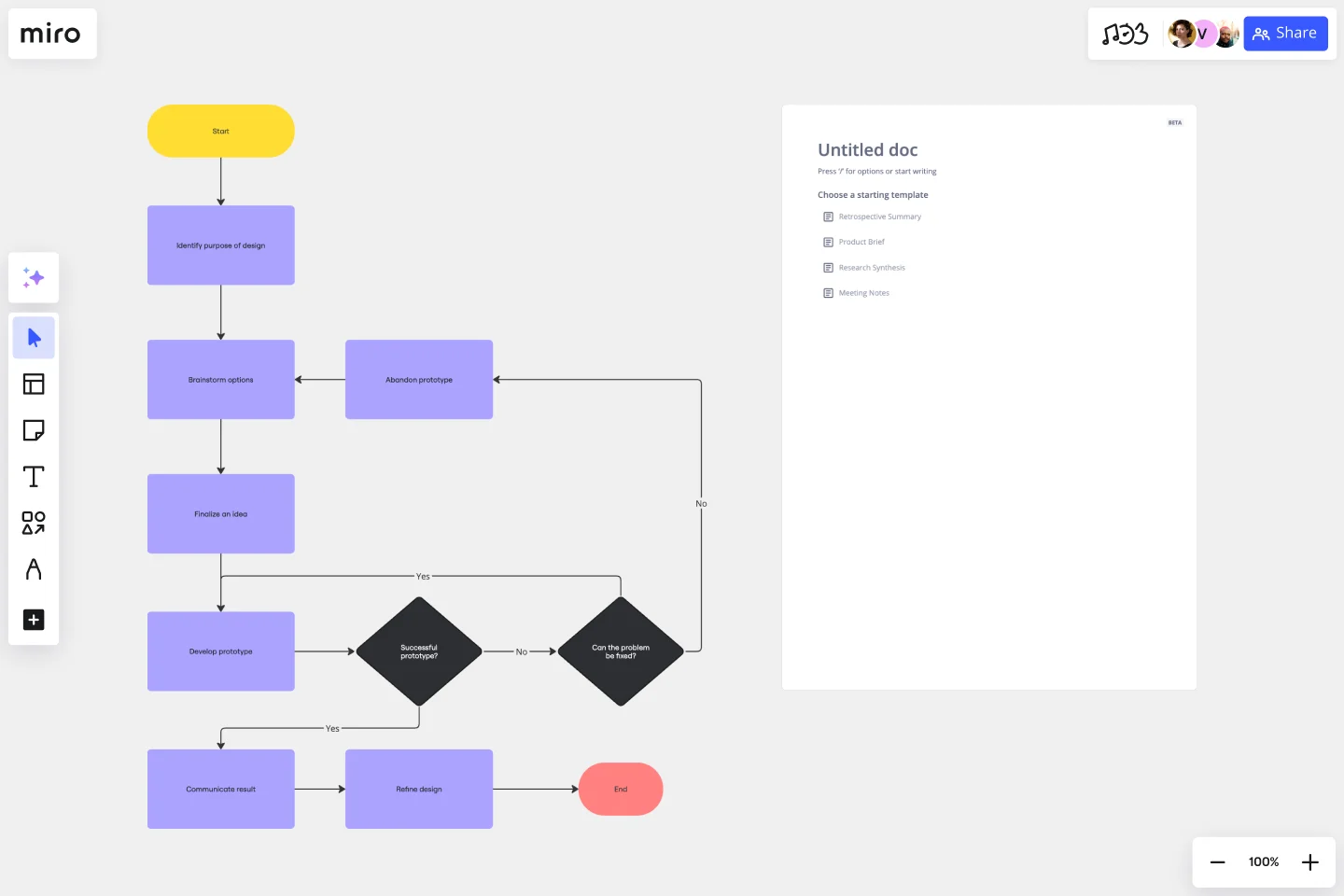Design Process Flowchart Template
Make the design process more transparent and manageable with the design flowchart process template, allowing for better planning, decision-making, and execution of design projects.
About the Design Process Flowchart Template
The process of designing involves creativity and attention to detail, often requiring a structured approach to bring ideas to life effectively. A design process flowchart template is a critical tool to navigate this journey. It provides a visual roadmap, outlining each step of the design process from conception to completion. This template helps organize thoughts, ideas, and actions, ensuring a smooth workflow and cohesive final product.
The design process flowchart template is a structured guide for designers and teams, mapping out the stages such as research, ideation, prototyping, testing, and finalization. By laying out these steps visually, the template makes the design process more transparent and manageable, allowing for better planning, decision-making, and execution of design projects.
How to use the design process flowchart template
Easy editing: Change the template to suit specific project needs by double-clicking shapes and lines. Adjust elements like text, shapes, and colors to reflect the unique aspects of the design process.
Expand the flowchart: Leverage advanced diagramming features to add more elements or detailed steps, enhancing its comprehensiveness without sacrificing clarity.
Add more resources: Drag and drop relevant files, links, or images to the board for a more enriched and context-aware design process.
Why should you use a design process flowchart template?
Streamlined workflow: Organizes and visualizes the design process, making it easier to follow and manage.
Facilitates creativity and innovation: Provides a structured approach that guides the creative process without stifling innovation.
Improves team collaboration: Enhances communication among team members by providing a clear and shared understanding of the project stages.
Customizable for many projects: Adaptable to different design projects, whether in graphic design, product development, or digital creation.
Effective project management: Help track progress, meet deadlines, and ensure a cohesive design outcome.
Can non-designers use this template effectively?
Yes, the template is designed to be user-friendly, making it accessible for non-designers to understand and participate in the design process.
How does this template help in managing large design projects?
For large projects, the template provides a clear overview of each phase, helping in breaking down complex tasks into manageable steps and ensuring all aspects of the project are addressed.
Can the flowchart be customized to include brand-specific elements?
The template is fully customizable, allowing the inclusion of brand-specific colors, fonts, and other elements to align with company branding.
Get started with this template right now.
AHA! Moment Flowchart
Works best for:
Mapping, Flowcharts
The AHA! Moment Flowchart template offers a visual tool for mapping out the journey of users or customers and identifying key moments of realization or insight (AHA moments). It provides a structured framework for documenting user interactions, emotions, and pain points throughout their journey. This template enables teams to understand user experiences, identify opportunities for improvement, and enhance product or service offerings. By promoting empathy and customer-centric design, the AHA! Moment Flowchart empowers organizations to create meaningful and impactful user experiences effectively.
Website Flowchart Template
Works best for:
Flowcharts, Mapping, User Experience
A website flowchart, also known as a sitemap, maps out the structure and complexity of any current or future website. The flowchart can also help your team identify knowledge gaps for future content. When you’re building a website, you want to ensure that each piece of content gives users accurate research results based on keywords associated with your web content. Product, UX, and content teams can use flowcharts or sitemaps to understand everything contained in a website, and plan to add or restructure content to improve a website’s user experience.
Project Management Flow Chart
Works best for:
Flowcharts, Diagrams, Mapping
The Project Management Flow Chart template offers a visual tool for planning and managing projects using flowchart diagrams. It provides elements for mapping out project phases, tasks, dependencies, and timelines. This template enables project managers and teams to visualize project workflows, identify critical paths, and track progress effectively. By promoting clarity and transparency, the Project Management Flow Chart empowers organizations to deliver projects on time, within budget, and according to specifications.
Screen Flow Template
Works best for:
UX Design, Product Management, Wireframes
A screen flow (or wireflow) brings together a multi-screen layout that combines wireframes with flowcharts. The result is an end-to-end flow that maps out what users see on each screen and how it impacts their decision-making process through your product or service. By thinking visually about what your customers are looking at, you can communicate with internal teams, stakeholders, and clients about the decisions you’ve made. You can also use a screen flow to find new opportunities to make the user experience frictionless and free of frustration from start to end.
Swim Lane Diagram with Data
Works best for:
Flowchart, Mapping, Diagrams
The Swim Lane Diagram with Data template is a visual tool for illustrating processes or workflows with swimlanes that contain additional data or information. It provides elements for documenting process steps, timelines, and performance metrics within each swimlane. This template enables teams to analyze process efficiency, identify bottlenecks, and make data-driven decisions for process improvement. By combining visual clarity with data insights, the Swim Lane Diagram with Data empowers organizations to optimize workflows and drive continuous improvement effectively.
If then Flowchart Template
Works best for:
Flowcharts
The If-then Flowchart Template is a useful tool for decision-making. It visually maps out conditional steps and outcomes, allowing users to anticipate potential challenges and opportunities. This foresight is valuable for making informed decisions, especially for those with significant implications. Whether for business strategy, project management, or personal decision-making, the template helps navigate complex decision trees with confidence.
